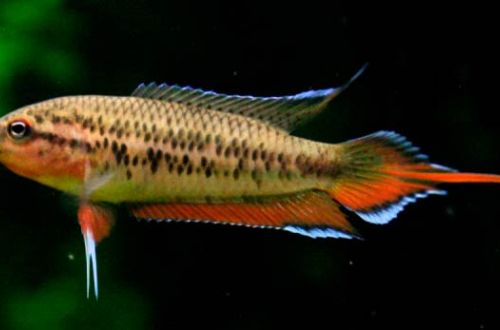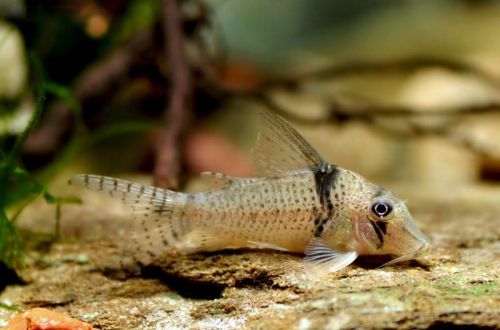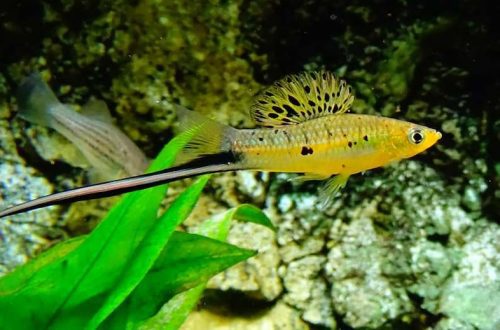
Kupanus ordinary
Common cupanus, scientific name Pseudosphromenus cupanus, belongs to the Osphronemidae family. The fish is named after the area in which it was discovered – the Arian Kupang River, now known as Sankararani. It is easy to keep, unpretentious and gets along well with fish of a comparable size. All this makes it a good choice for beginner aquarists as well.

Contents
Habitat
It comes from the southern provinces of India. It is found in the Sankararani River basin, which flows through the Indian state of Tamil Nadu, and in river systems on the nearby island of Sri Lanka. Initially, it was believed that the habitat also covers Bangladesh, Indonesia, Malaysia, Myanmar and Pakistan, but later studies have refuted this version.
Inhabits coastal areas of rivers and streams with slow flow and dense aquatic vegetation, as well as stagnant water bodies such as swamps, lakes, ponds, rice fields.
Brief information:
- The volume of the aquarium – from 50 liters.
- Temperature – 20-28°C
- Value pH — 6.0–7.5
- Water hardness – 2–26 dGH
- Substrate type – any
- Lighting – subdued
- Brackish water – no
- Water movement – little or no
- The size of the fish is about 6 cm.
- Food – live or frozen food
- Temperament – peaceful
- Content – in a group of relatives or with other small species
Description
Adults reach a length of about 6 cm. The color is gray with dark pigmentation running along the middle of the body from head to tail. With the onset of the mating season, males begin to show bright red colors on the anal and caudal fins and turquoise edging. Females darken, acquire dark gray colors.
Food
Often referred to as an omnivorous species, however, not all commercially available fish accept dry food, so it is worth clarifying your usual diet before buying. The basis of the diet is usually live or frozen foods such as brine shrimp, daphnia, bloodworms. It is allowed to use other small insects, mosquitoes and their larvae, fruit flies, etc.
Maintenance and care, arrangement of the aquarium
The optimal size of the aquarium for one pair of fish starts from 50 liters. Unlike other related species, the content is quite simple. The fish is not demanding in terms of design (some breeders do not even use the substrate) and the hydrochemical composition of the water, it successfully adapts to a fairly wide range of pH and dGH values. For the purpose of breeding, it is worth providing several places for shelters where the fish can form a clutch. For example, shelters can be formed from natural snags and thickets of plants, as well as from any decorative items. If the design does not matter, ordinary ceramic pots and other vessels turned over on their sides, fragments of PVC pipes, etc. will do.
A useful addition will be the leaves of some trees, which cover the surface of the soil. They are not only part of the natural decor, but also affect the chemical composition of water. When decomposed, tannins are released. Similar processes occur in nature when leaves, tree branches and other plant material enter water bodies.
An important condition for successful maintenance is to ensure stable water conditions. To this end, the aquarium is equipped with the necessary equipment, primarily a filtration system, and a number of mandatory maintenance procedures are carried out: weekly replace part of the water (10–15% of the volume) with fresh water and remove organic waste (food residue, excrement).
Behavior and Compatibility
Peaceful friendly fish. Due to its size, it will not be able to compete with large species, so the latter should be avoided. Compatible with many small and non-aggressive fish.
Breeding / breeding
Breeding cases are not uncommon if the fish are kept in a suitable environment and receive a balanced diet. With the onset of the breeding season, as noted above, the males acquire bright colors and begin to build a nest from air bubbles mixed with pieces of plants. The nest is built under the surface of wide leaves or in cavities, like caves – the same pots and PVC pipes. When construction is completed, the courtship process begins. Having formed a temporary pair, the male and female lay several dozen eggs. Males stay close to the clutch to protect future offspring. Parental instincts begin to weaken only when the fry begin to swim on their own. It is advisable to transfer the juveniles to a separate tank in order to avoid predation by other fish.
Fish diseases
A well-established biological system, a balanced diet and the absence of stressful situations (for example, being chased by aggressive fish) are the best guarantee of maintaining health. When the first signs of an illness appear, first of all, attention should be paid to these three factors, perhaps there was a deviation in one of them. As a rule, solving the problem leads to self-healing. However, if the immune system fails, you will have to resort to medical treatment. Read more about symptoms and treatments in the Aquarium Fish Diseases section.





